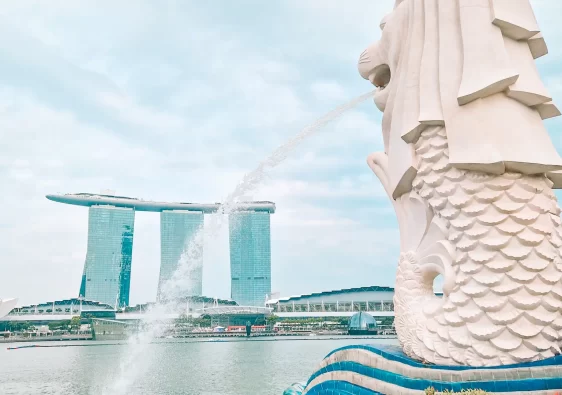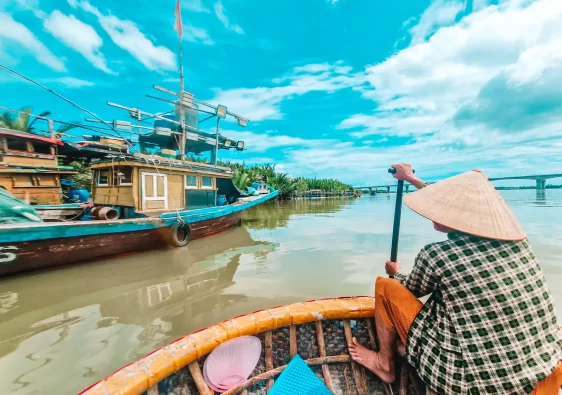Wondering what to do in Kampot, Cambodia? You’re in the right place. Tucked away in the country’s south, Kampot is one of those rare destinations that still feels like a hidden gem—quiet, scenic, and wonderfully unpolished. It’s often overshadowed by Cambodia’s more well-known spots, but that’s exactly what makes it special. If you’ve been craving something more authentic than temple tours and party hostels, Kampot delivers with peaceful salt flats, colonial charm, riverside cafes, and slow travel energy in spades.
Just so you know, this post contains affiliate links. If you book a tour, hotel, or buy something through one of these links, I may earn a small commission—at no extra cost to you. It helps me keep this blog running and full of travel tips. Thanks for the support!
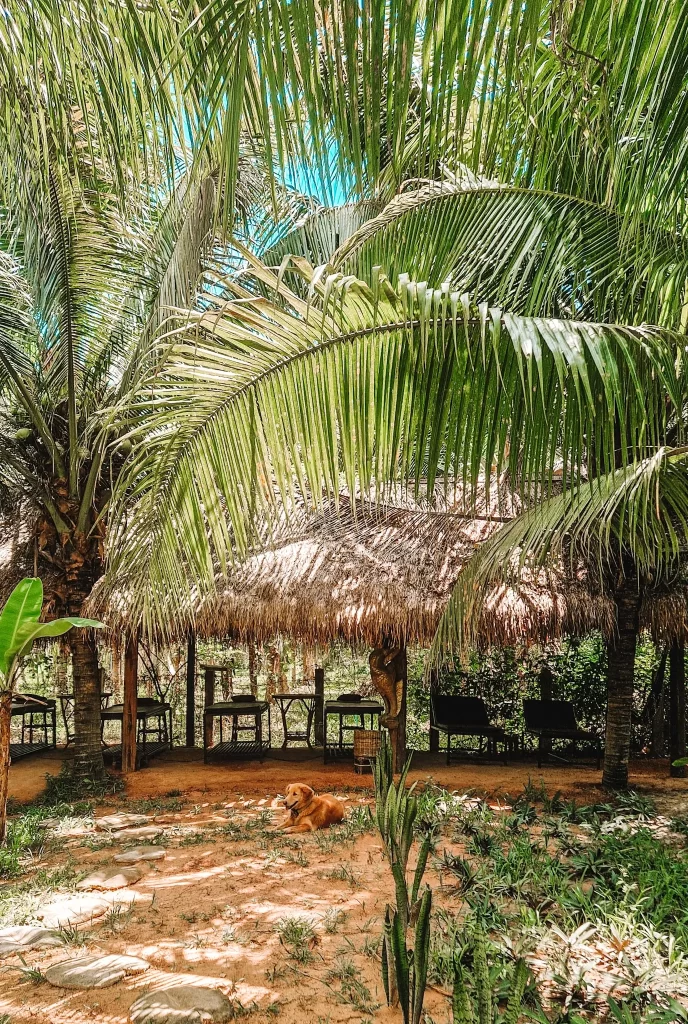
Is Kampot worth visiting?
I explored Kampot in May 2025 and spent time uncovering experiences that go beyond the typical tourist checklist—like a day at the serene Banteay Srey Women’s Spa, a tranquil ride out to the pepper plantations, and a salty, sun-kissed trip to the nearby town of Kep.
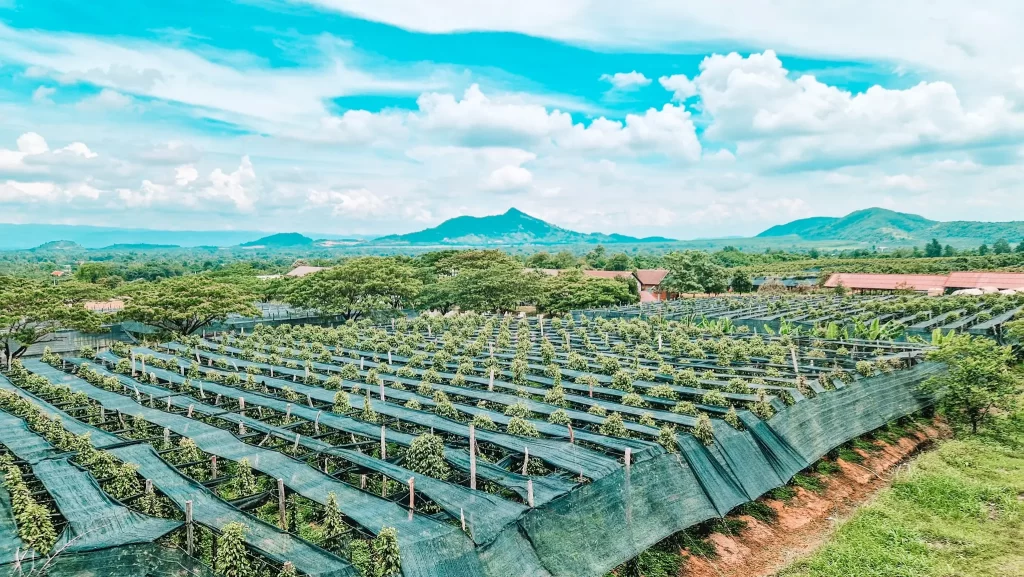
While Kampot shouldn’t take the place of Siem Reap on your Cambodia itinerary, this small, peaceful town is well worth a visit if you have time in your schedule. Similar to my visit to Battambang, I loved my time in Kampot for the slow pace of life and relative lack of major tourist attractions. Compared to the incredible but busy time I spent in Siem Reap at Angkor Wat, or the gruelling but necessary exploration of Cambodia’s history in Phnom Penh, there are relatively few things to do in Kampot – but that’s part of the charm.

Whether you’re travelling solo, working remotely, or just after a deeper, slower travel experience, this guide highlights what to do in Kampot while keeping it real, practical, and inspiring. Let’s get into it.
Short history of Kampot
The small riverside town of Kampot was founded around 1,500 years ago, but rose to prominence in the 19th century under French colonial rule. It became a vital port and administrative center, known for its colonial architecture, salt fields, and world-renowned pepper plantations. Kampot declined after independence and during the Khmer Rouge era but has revived in recent decades as a cultural and tourism hub, blending its French heritage with a relaxed riverside charm.
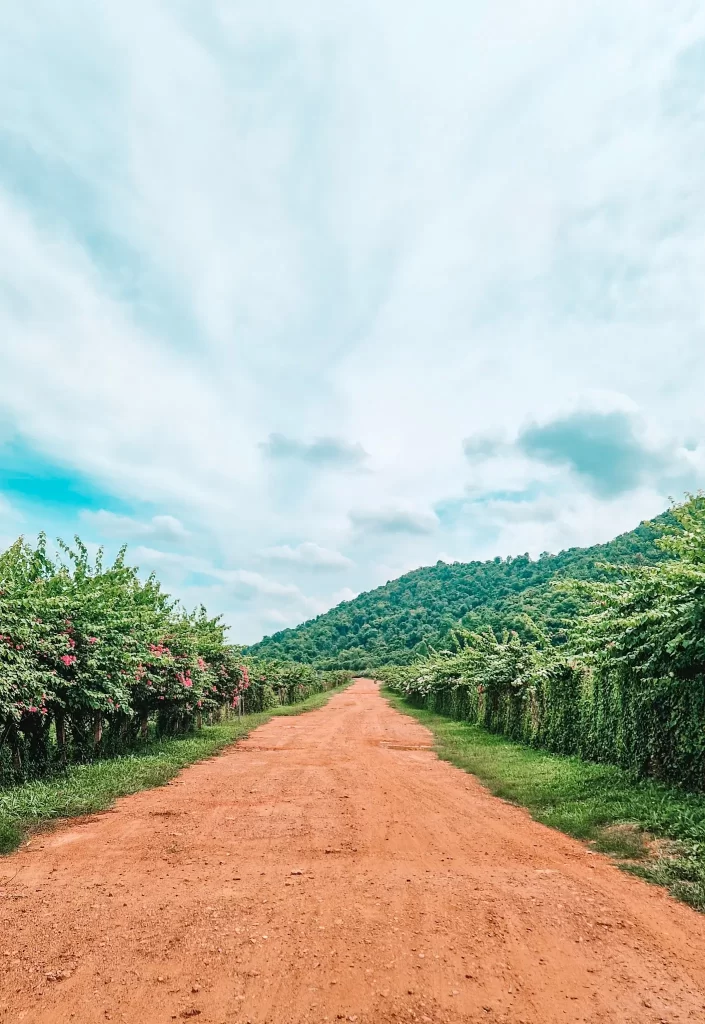
If you’re interested in the history of Cambodia, there is a novel that covers both recent and Angkor-era history on my list of books about Southeast Asia.
What to do in Kampot: The top 5 things to do in 2025
Visit the wonderful Banteay Srey Women’s Spa
Cost: $35
The best thing I did in Kampot when I visited in May 2025 was to take a day out of my busy schedule and relax at the beautiful Banteay Srey Women’s Spa. This NGO supports local Khmer women to build careers that lead to well-paid jobs, and includes a vegan restaurant and eco-village as well as the spa.
Sex tourism is still a major problem in Cambodia, and is very visible in Kampot. Ensuring that women have alternative employment opportunities is incredibly important in helping to break this cycle.
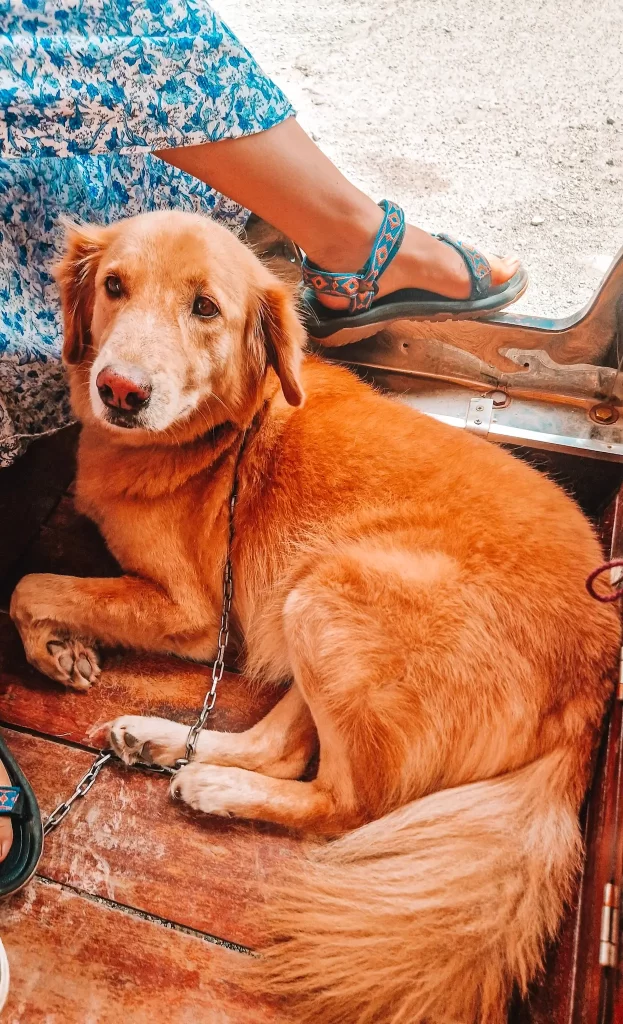
The spa day starts at 11am, with pick up from Kampot. After a tuk tuk drive (with the beautiful Moo if you’re lucky, the only male allowed in the spa), you’ll arrive at the spa in time for tea and then lunch. We ate delicious local Khmer food, freshly prepared, and then the real relaxation began.
Upstairs, we changed into our sarongs before creating our own traditional Khmer body scrub. We ground up ginger, kaffir lime, tamarind and other ingredients, learning about their medicinal properties as we went. After, it was time to use the scrub in the on-site steam room, before our full-body massages and a dip in the fresh-water pool.
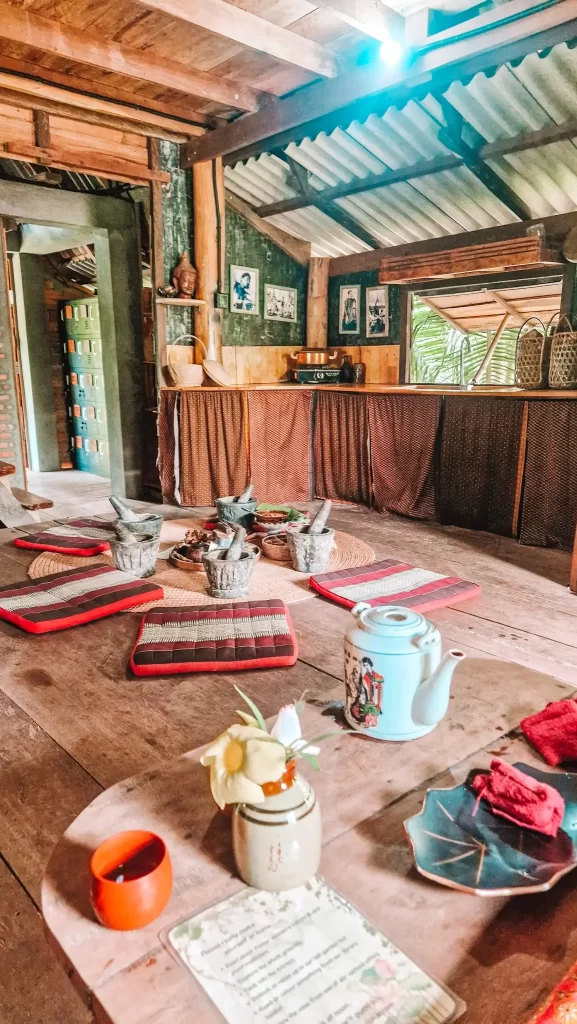
I can’t even begin to describe how amazing this experience was. It’s perfectly curated, and there’s much more included than I’ve mentioned above (I don’t want to ruin any surprises!).
It felt amazing to take a day just to rest and have time to myself – we were silent for much of the day. Finally, you get relax knowing that you’re supporting an amazing NGO that’s empowering local women.
Visit La Plantation
When you’re thinking about what to do in Kampot, this is probably the first thing that comes to mind. Kampot is famous for pepper, which has a protected status similar to DOCG in Europe. Founded in 2013, La Plantation is the leading producer of Kampot Pepper, and the most famous place to go for a tasting.
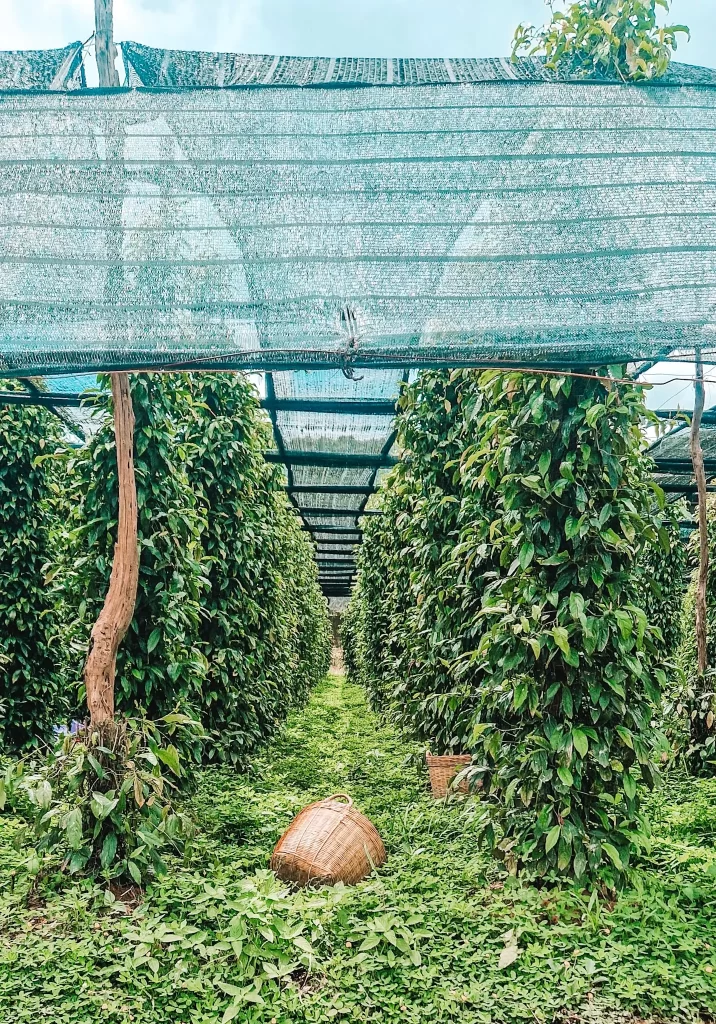
The farm is a long way out of town, so you’ll either need to hire a tuk tuk or join a tour. You’ll bump down a winding road before coming to the lush planation, which also includes herbs like lemongrass as well as the different types of pepper. You can join a free tour, which also includes a tasting, and helps you understand the impact that La Plantation has had on the local community. This includes getting protected status for the pepper (which improves life for other smaller plantations as well), supporting local children to attend school and creating employment opportunities.
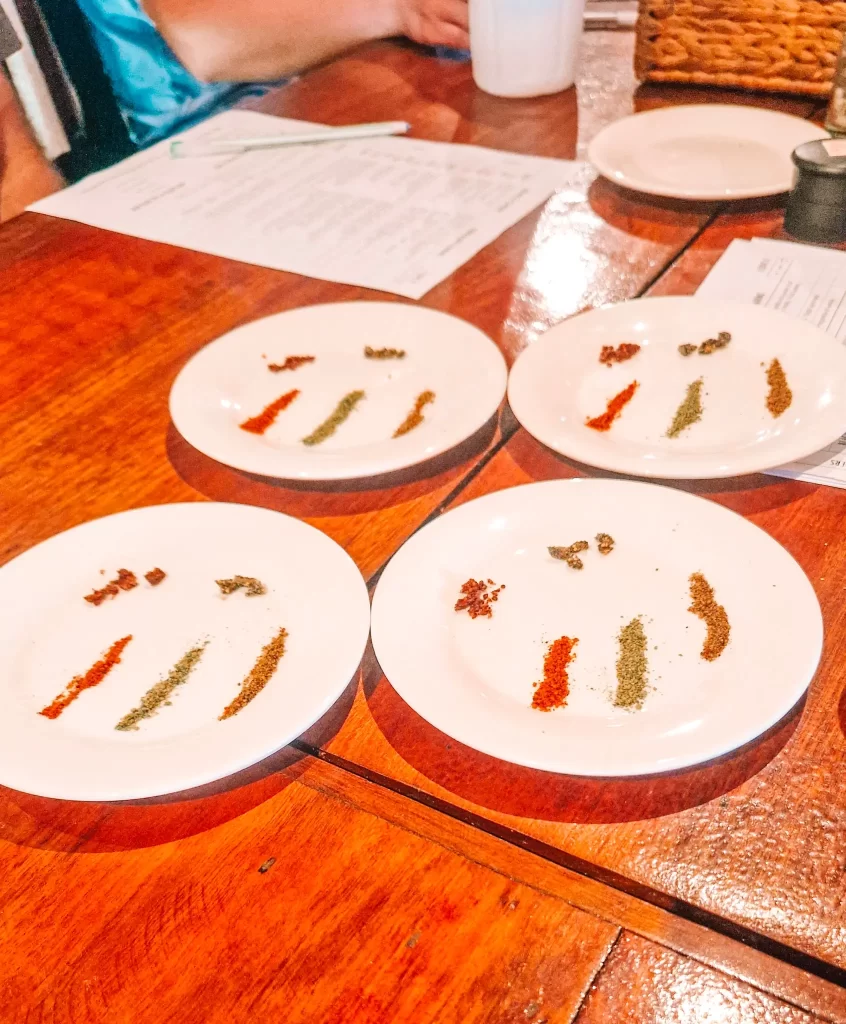
After your tour, head up to the beautiful new Spice Bar for a coffee and a chance to soak up the views. I visited on a Khmer national holiday and the cafe was incredibly crowded, but I could see that on a normal day it would be a tranquil spot to take in the beauty of the surrounding area. End your tour by stopping at the shop downstairs and trying some of their herbal teas, or buying endless types of pepper for your friends and family.
Visit the Kampot Salt Flats
Salt is a major industry in Kampot, and on your way to La Plantation you can stop off at the Kampot Salt Flats to learn about it. The salt flats are set up to be irrigated by the nearby sea, and locals harvest the salt, which is then sent to Phnom Penh for processing. The salt trade employs around 1.5k people in Kampot, and salt from the Kampot-Kep region has received the same protected Geographic Indication status as Kampot Pepper.
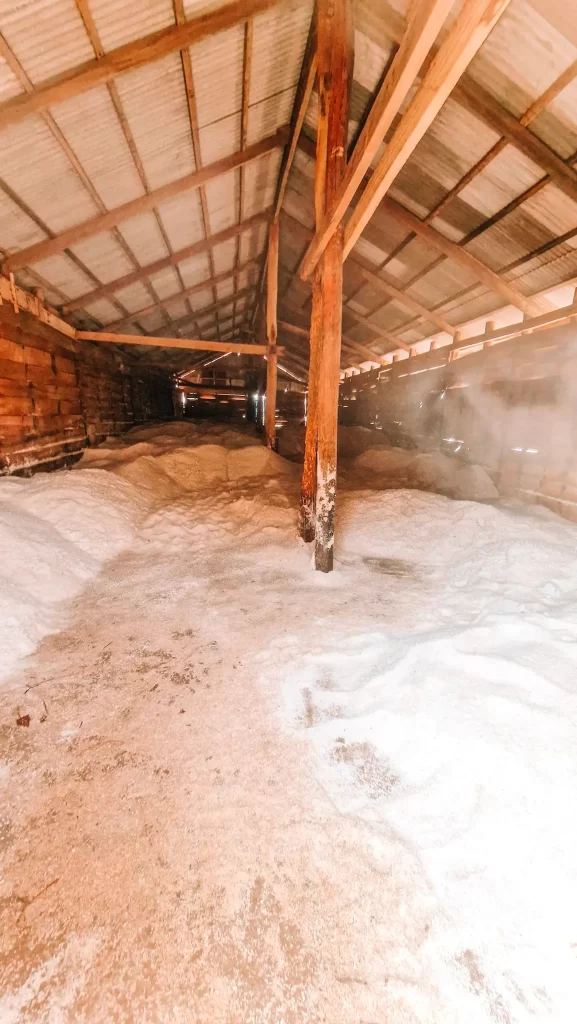
You won’t need to spend long at the Kampot Salt Flats, but it’s worth a visit to understand the important part this industry plays in the local economy, and to take some beautiful pictures.

As part of your journey, you can also visit Kampot’s Secret Lake. This lovely, peaceful spot is on the road to La Plantation, and its worth a few minutes to stop and take in the view. This man-made lake was full of locals fishing when I visited and reminded me of the fishing village I visited on the Hai Van Pass in Vietnam.

Spend a day on the beach in Kep
Just down the road from Kampot, Kep is the town’s quieter seaside sister. Famous for the incredibly busy Crab Market, where you can eat Kep Crab served with Kampot Pepper, the beach is also a popular domestic tourism spot.

Spend half a day at Kep, taking in the Crab Market before relaxing on the pretty beach. It’s another chance to relax in this quieter part of Cambodia. If you’re feeling adventurous, you can also get a boat across to the famous Rabbit Island, which is famous for snorkelling, but as yet very undeveloped in terms of tourism.
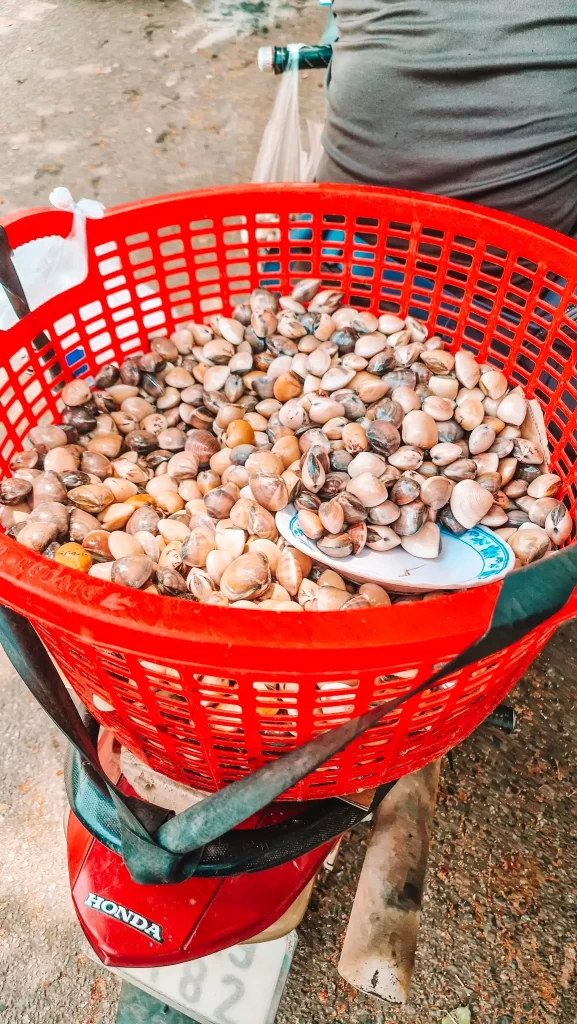
Spend the afternoon at Sabay Beach
Just outside of Kampot town is the beautiful Sabay Beach, a luxuriously rustic riverside hotel with its own beach and high-end restaurant. I was lucky to spend a couple of nights at the glorious Sabay Beach, but even if you’re not staying there you can pop in to enjoy the beauty.

Visit for a delicious lunch and spend the afternoon soaking up the sun on their little beach, taking the occasional dip into the river when you need to cool down. Grab one of their Kampot Pepper cocktails as the sun goes down (I recommend the white pepper version) and enjoy the absolute serenity of this beautiful spot.
Sabay Beach is around 15 minutes from central Kampot by tuk tuk. If you’re not staying there, tuk tuks are easy to get from the hotel back to the city centre.
If you fancy a stay at Sabay Beach, consider their beautiful treehouses (where I stayed) or even their riverside bungalow, which has direct water access and private sunloungers. This is a truly unique spot to stay – just be aware that you might be sharing your room with some pretty huge geckos (the biggest I’ve seen in 10 months of travel!).
Honourable mentions
As ever, there are some things I didn’t get to do while I was in Kampot, but that are highly recommended. In this case, I had a foot injury that stopped me from doing too much exploring and wasn’t able to get to Bokor National Park or to kayak – I’ll just have to go again!
Visit Bokor National Park
Visiting Bokor National Park is probably the most famous thing to do in Kampot. This beautiful area was established as a national park in 1993, but like Penang Hill in George Town, the Cameron Highlands near Ipoh in Malaysia, and Sapa in Vietnam, it became a colonial favourite, as it was much cooler than the stifling heat of nearby Kampot.
Most people will visit the national park as part of an organised tour, often by tuk tuk. You’ll get to visit Bokor Hill Station, the old colonial outpost, and see the relics of Cambodia’s French past. You’ll also get to see the famous Wat Sampov Pram, a Buddhist temple known as the ‘Five Boats Pagoda’, which offers stunning views of the surrounding area, as well as taking in the beauty of Popokvil Waterfalls.
Most hotels in Kampot offer tours for Bokor National Park, so it’s easy to find the right option for you once you arrive. There are also hiking tours available for people who are more adventurous than I am!
Go kayaking down peaceful rivers
The rivers around Kampot are a haven for kayaking and offer a lovely opportunity for peace and serenity. There are many tour companies in the area offering kayaking tours, and this is something I would have loved to do if my foot hadn’t been injured.
Freqently asked questions
Should you visit Kep or Kampot?
This was a question I struggled with before my trip, and in the end I was really glad I chose Kampot. It’s a bigger town with a bit more depth than Kep, which is purely a seaside fishing town. I loved the social enterprise scene in Kampot, as well as the abundance of good restaurants and cafes (cafe post coming soon!). However, if you love eating seafood, or just want to sit on the beach, then Kep might be the right choice for you.
I also happened to be in Kampot over a national holiday weekend, and Kep was incredibly crowded when I visited – take this into account when making your decision.
When is the best time to visit Cambodia
Cambodia has a tropical climate with two main seasons: dry (October–April) and wet (May–September). The best time to visit is October–February, when temperatures are cooler and the landscape is lush from recent rains.
✔ Best months to visit: October & November (cool, green, and less crowded).
✔ Peak tourist season: December–February (cool, but busiest).
❌ Avoid: March–June (extremely hot) & August–September (heaviest rain).
I visited in May 2025 and can confirm that the heat was intense!
Is Kampot safe?
The biggest risk to tourists in Cambodia, as in much of Southeast Asia, is bag snatching and theft. The British Foreign, Commonwealth and Development Office (FCDO) warns that this is prevalent in tourist hotspots, and particularly in Phnom Penh. Always keep your bag close, especially in tuk tuks or when walking—hold it on the side away from the road to prevent snatching.
While Kampot is generally safe, it is a quiet town and there aren’t many people around. Exercise caution, particularly at night. Make use of Grab to get you to and from your hotel if you’re outside the main tourist area.
How to get to Kampot from Phnom Penh
The easiest way to get to Kampot is from Phnom Penh, which is the central point for bus travel within Cambodia. It takes about 3-4 hours to get from Phnom Penh to Kampot, depending on traffic. Buses will depart from the bus office in central Phnom Penh and arrive in central Kampot.
If you prefer, you can also arrange a private transfer from Phnom Penh to Kampot. Ask your hotel in either Kampot or Phnom Penh to arrange this for you.
From Phnom Penh, you can reach destinations across Cambodia such as Siem Reap and Battambang, as well as get international buses to cities like Bangkok and Ho Chi Minh City, or the beautiful 4000 Islands in Laos. Finally, Phnom Penh has the most extensive international airport in Cambodia, offering flights to destinations including Kuala Lumpur and Singapore.
How to get from Kampot to Koh Rong or Koh Rong Samloem
You can travel directly between Kampot and the paradise islands of Koh Rong and Koh Rong Samloem. Vireak Buntham are partnered with Buva Sea and offer an inclusive ticket with both the bus and boat legs of the journey. The total journey time will take 3.5 hours or more, depending on where your ferry stop is on the islands.
Safety concerns: While I recommend Vireak Buntham, I have some reservations about Buva Sea and recommend that you look at their Google Reviews before making a decision. When I travelled with them in November 2025, there were recent Google Reviews highlighting significant safety concerns (like boats capsizing). If you are staying at one of the more mainstream resorts or towns on the islands, I recommend using Vireak Buntham to get to Sihanoukville and then transferring to G.T.V.C., which had much more positive Google Reviews. However, if you are staying at one of the smaller, remote beaches, Buva makes more stops so might be your only choice. I used G.T.V.C. on the way out and Buva Sea on the way back, and there was a visible difference in the quality of the boats and safety equipment.
How to get to Kampot by bus
After reading reviews and taking tips from other travellers, these are the bus companies I used while in Cambodia:
Vireak Buntham – the biggest provider of buses in Cambodia, with extensive routes and times. Vireak Buntham run a luxury minivan from Phnom Penh to Kampot, which has fewer seats and therefore more space than other providers. The Vireak Buntham depot in Phnom Penh is a decent size, with clean toilets, a waiting area and a minimart on site.
Giant Ibis – a smaller company which offers fewer departures between Kampot and Phnom Penh. Giant Ibis make a point of saying on their website that they always have two drivers on board, and encourage drivers to drive slowly to promote safety. I’ve also seen videos of them breathalysing drivers before departure, though I’ve never seen this in person.
How to get around in Kampot
The best way to get around in Kampot is by tuk tuk. You can either join an organised tour or hire your own tuk tuk driver for the day depending on your budget and timings.
Cambodian currency and money
These are some practical tips that will make your life easier in Cambodia:
Currency: confusingly, Cambodia uses both the US Dollar and Cambodian Riels, completely interchangeably. Be prepared to do a lot of maths while you’re in Kampot! It is very common to pay in one currency and be given change in the other. To deal with this:
Bring a mixture of Riel and Dollars
Stay aware of the exchange rate
Always check your change
I visited Cambodia in November 2024 and May 2025. Both visits, the exchange rate was usually set at 4000 Riels/$1, so get ready to do your 4X Table.
Using US Dollars: these must be pristine and won’t be accepted otherwise. Bring a purse or wallet that allows you to keep notes in mint condition. Do not accept damaged or worn US dollars as change—they may not be accepted elsewhere.
ATMs: ATMs are easily accessible in Cambodia, as are money exchanges. There are ATMs in the centre of Kampot.
Changing money: I prefer to use a card that doesn’t charge for withdrawals (for example, the Chase debit card or Halifax credit card in the UK). If you want to have money on you when you land rather than using an ATM, search for the best rates in your home country before you travel rather than changing at the airport. I never recommend changing money at an airport, as exchange rates will be much higher.
Are there mosquitoes in Kampot?
Mosquitoes are common in Kampot, especially during the rainy season! You can buy good (and delicious smelling) repellent very easily in Cambodia, but it won’t have DEET. If you really want DEET repellent, it’s best to bring this with you.
Where to stay in Kampot
I stayed in two hotels, and recommend them both for different reasons:
Orchid 101 is a friendly guesthouse near the centre of Kampot. While it’s not fancy, it is comfortable, clean and well-set up. They offer free filtered water, and a good value breakfast. The British-Filipino couple who own it are friendly and incredibly helpful, and I loved my stay here.
Sabay Beach, seen above, is a really unique stay. Choose a treehouse, or a riverfront cottage. The hotel is outside of town, so it’s quiet and peaceful, and the food is excellent.
Kampot might not be the loudest destination on the map, but that’s exactly its charm. With its laid-back vibe, rich local culture, and a handful of truly memorable experiences, it’s the kind of place that lingers in your mind long after you’ve moved on. If you’re looking to slow down, connect, and discover something a little different, Kampot is more than worth your time.

